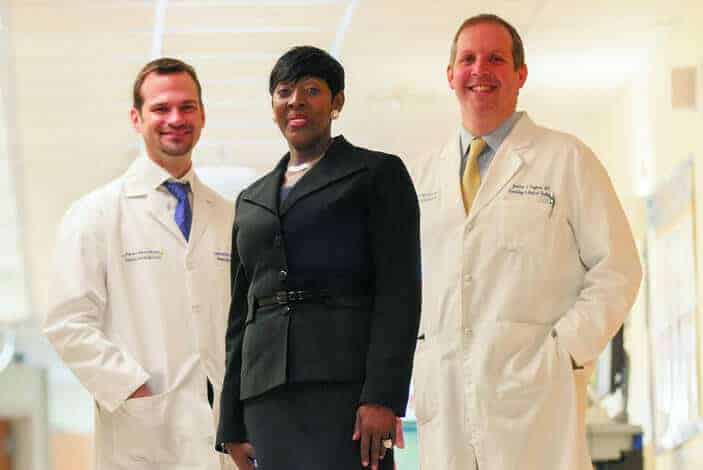Genetic research is a key to understanding how either race or ethnicity affect the incidence of different cancers and how these factors may contribute to different responses to the same treatments. Multiple myeloma, a blood cancer of the immune system’s plasma cells, occurs two to three times more often in African Americans than in Caucasians. Finding out why could lead to better therapies for all. Winship Cancer Institute researchers couldn’t do it without people like Veronica Reynolds.
In her mid-50s, the busy realtor developed severe pain. She asked herself if she had strained her back, driving back and forth showing houses or picking up grandchildren? She told herself it would go away. It got worse. One doctor told her she looked too well to hurt as much as she claimed. Another believed her but his pills barely helped. After two years, she feared her heart would stop from pain. At Grady Memorial Hospital, imaging revealed fractured bones, due to bone destruction. Other tests provided the multiple myeloma diagnosis – and led Reynolds to Leon Bernal-Mizrachi, a Winship hematologist/oncologist who sees patients at Grady.
Reynolds credits God for sending her to Bernal-Mizrachi and to Jonathan Kaufman, director of Winship’s ambulatory infusion center, who oversaw her stem cell transplant following high dose chemotherapy. She credits herself for following the complex treatment regimens. And she’s “ecstatic,” she adds, about being part of her doctors’ research. “I hope I have enough fight in me to live to see it help many people like me.”
Reynolds — and her genes — are part of a massive multiinstitutional study to sequence the entire genome (more than three billion DNA base pairs) of 1,049 African Americans with multiple myeloma and another 7,084 without the disease. The Winship component, headed by Sagar Lonial, Bernal-Mizrachi, and Ajay Nooka, has gathered almost a third of the study’s participants, thanks to the researchers’ commitment and Georgia’s high African-American population. Although still in process, the study is already producing valuable insights. Winship physicians routinely take tissue cells from multiple myeloma patients, looking for genetic variants that indicate who is at higher risk of relapse. They hope this new study will help identify why this disease occurs more frequently among African Americans and determine if there are treatments that may be specific to these patients.
Winship researchers also are looking at genetic differences in another blood cancer, diffuse large B-cell lymphoma (DLBCL), the most common form of non-Hodgkin lymphoma. Compared to Caucasians, African Americans have a lower incidence of DLBCL – but are more often younger, with more advanced disease, and a lower chance of surviving. A multi-institutional study headed by Winship hematologist/oncologist Christopher R. Flowers, director of the Emory Lymphoma Program, is finding subtle genetic differences, depending on race, in DLBCL subtypes. This builds on earlier work by Bernal-Mizrachi’s team, which demonstrated that different subtypes have different signaling pathways (cells that activate cell division and other functions). Abnormal activation can lead to cancer and cancer cell growth. The long-term goal is to develop new drugs to block different pathways. But the Bernal-Mizrachi team already has demonstrated that using different existing drugs, depending on patients’ subtypes, itself positively changes outcomes.
In fact, Bernal-Mizrachi says new drugs are changing how clinicians view racial disparities. For years, African-American multiple myeloma patients were believed to have poorer outcomes after autologous stem cell transplants (transplants using the patient’s own stem cells), like that given Reynolds. But a recent Emory study of transplants from 2006 to 2012 showed newer maintenance drugs had improved outcomes for both blacks and whites. In fact, preliminary results indicate African Americans may actually have longer progression-free survival, suggesting a difference in response to the new drugs, something which Nooka, Kaufman, Lonial, and Bernal-Mizrachi are examining.
Winship researchers are aggressively investigating the genetic disparities of several other cancers, including prostate and triple-negative breast cancers. They also are asking whether behavioral or environmental factors play a role. The large multiple myeloma study found that being obese at 20 or younger increased the risk of developing the cancer and of developing it at a younger age. Lonial’s team is investigating whether rural Georgia’s high rate of myeloma is related to agricultural or pesticide exposure. Flowers’ team looked at the relationship between the dramatic rise in non-Hodgkin lymphoma and exposure to benzene, a chemical in plastics, detergents, and pesticides. The researchers found significantly more cases near manufacturing facilities that release benzene into the environment, with a 0.31 percent decrease in risk for every extra mile of distance from benzene release sites.
If our reporting has informed or inspired you, please consider making a donation. Every contribution, no matter the size, empowers us to continue delivering accurate, engaging, and trustworthy science and medical news. Independent journalism requires time, effort, and resources—your support ensures we can keep uncovering the stories that matter most to you.
Join us in making knowledge accessible and impactful. Thank you for standing with us!

